Siran Yang
Part I: Tricks or Traps? A Deep Dive into RL for LLM Reasoning
Aug 11, 2025Abstract:Reinforcement learning for LLM reasoning has rapidly emerged as a prominent research area, marked by a significant surge in related studies on both algorithmic innovations and practical applications. Despite this progress, several critical challenges remain, including the absence of standardized guidelines for employing RL techniques and a fragmented understanding of their underlying mechanisms. Additionally, inconsistent experimental settings, variations in training data, and differences in model initialization have led to conflicting conclusions, obscuring the key characteristics of these techniques and creating confusion among practitioners when selecting appropriate techniques. This paper systematically reviews widely adopted RL techniques through rigorous reproductions and isolated evaluations within a unified open-source framework. We analyze the internal mechanisms, applicable scenarios, and core principles of each technique through fine-grained experiments, including datasets of varying difficulty, model sizes, and architectures. Based on these insights, we present clear guidelines for selecting RL techniques tailored to specific setups, and provide a reliable roadmap for practitioners navigating the RL for the LLM domain. Finally, we reveal that a minimalist combination of two techniques can unlock the learning capability of critic-free policies using vanilla PPO loss. The results demonstrate that our simple combination consistently improves performance, surpassing strategies like GRPO and DAPO.
Reinforcement Learning Optimization for Large-Scale Learning: An Efficient and User-Friendly Scaling Library
Jun 06, 2025Abstract:We introduce ROLL, an efficient, scalable, and user-friendly library designed for Reinforcement Learning Optimization for Large-scale Learning. ROLL caters to three primary user groups: tech pioneers aiming for cost-effective, fault-tolerant large-scale training, developers requiring flexible control over training workflows, and researchers seeking agile experimentation. ROLL is built upon several key modules to serve these user groups effectively. First, a single-controller architecture combined with an abstraction of the parallel worker simplifies the development of the training pipeline. Second, the parallel strategy and data transfer modules enable efficient and scalable training. Third, the rollout scheduler offers fine-grained management of each sample's lifecycle during the rollout stage. Fourth, the environment worker and reward worker support rapid and flexible experimentation with agentic RL algorithms and reward designs. Finally, AutoDeviceMapping allows users to assign resources to different models flexibly across various stages.
CombatVLA: An Efficient Vision-Language-Action Model for Combat Tasks in 3D Action Role-Playing Games
Mar 12, 2025Abstract:Recent advances in Vision-Language-Action models (VLAs) have expanded the capabilities of embodied intelligence. However, significant challenges remain in real-time decision-making in complex 3D environments, which demand second-level responses, high-resolution perception, and tactical reasoning under dynamic conditions. To advance the field, we introduce CombatVLA, an efficient VLA model optimized for combat tasks in 3D action role-playing games(ARPGs). Specifically, our CombatVLA is a 3B model trained on video-action pairs collected by an action tracker, where the data is formatted as action-of-thought (AoT) sequences. Thereafter, CombatVLA seamlessly integrates into an action execution framework, allowing efficient inference through our truncated AoT strategy. Experimental results demonstrate that CombatVLA not only outperforms all existing models on the combat understanding benchmark but also achieves a 50-fold acceleration in game combat. Moreover, it has a higher task success rate than human players. We will open-source all resources, including the action tracker, dataset, benchmark, model weights, training code, and the implementation of the framework at https://combatvla.github.io/.
Boosting Large-scale Parallel Training Efficiency with C4: A Communication-Driven Approach
Jun 07, 2024

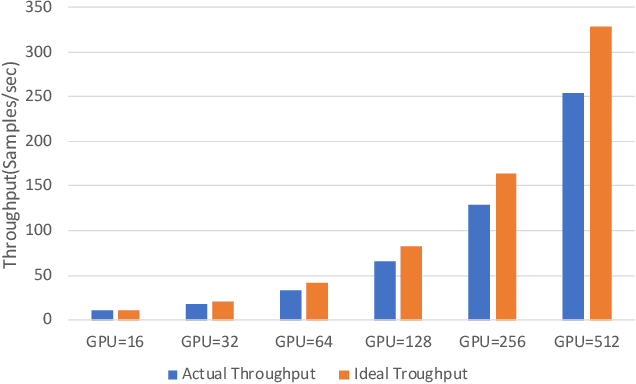

Abstract:The emergence of Large Language Models (LLMs) has necessitated the adoption of parallel training techniques, involving the deployment of thousands of GPUs to train a single model. Unfortunately, we have found that the efficiency of current parallel training is often suboptimal, largely due to the following two main issues. Firstly, hardware failures are inevitable, leading to interruptions in the training tasks. The inability to quickly identify the faulty components results in a substantial waste of GPU resources. Secondly, since GPUs must wait for parameter synchronization to complete before proceeding to the next round of computation, network congestions can greatly increase the waiting time for GPUs. To address these challenges, this paper introduces a communication-driven solution, namely the C4. The key insights of C4 are two folds. First, in parallel training, collective communication exhibits periodic and homogeneous characteristics, so any anomalies are certainly due to some form of hardware malfunction. By leveraging this feature, C4 can rapidly identify the faulty components, swiftly isolate the anomaly, and restart the task, thereby avoiding resource wastage caused by delays in anomaly detection. Second, the predictable communication model of collective communication, involving few large flows, allows C4 to efficiently execute traffic planning, substantially reducing network congestion. C4 has been extensively implemented across our production systems, cutting error-induced overhead by roughly 30% and enhancing runtime performance by about 15% for certain applications with moderate communication costs.
Rec4Ad: A Free Lunch to Mitigate Sample Selection Bias for Ads CTR Prediction in Taobao
Jun 06, 2023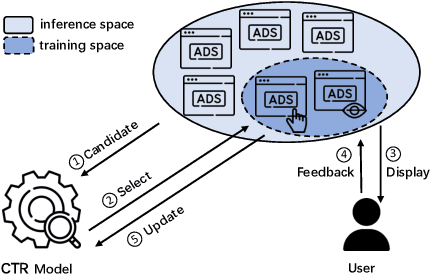
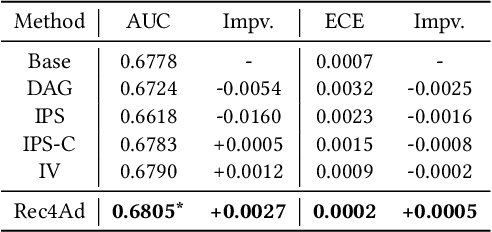
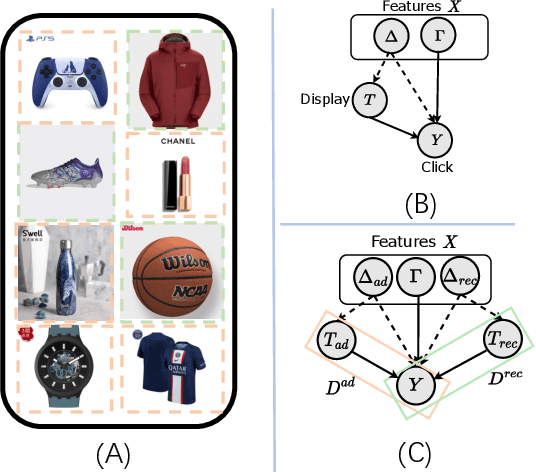
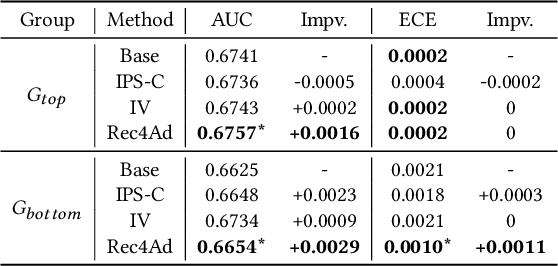
Abstract:Click-Through Rate (CTR) prediction serves as a fundamental component in online advertising. A common practice is to train a CTR model on advertisement (ad) impressions with user feedback. Since ad impressions are purposely selected by the model itself, their distribution differs from the inference distribution and thus exhibits sample selection bias (SSB) that affects model performance. Existing studies on SSB mainly employ sample re-weighting techniques which suffer from high variance and poor model calibration. Another line of work relies on costly uniform data that is inadequate to train industrial models. Thus mitigating SSB in industrial models with a uniform-data-free framework is worth exploring. Fortunately, many platforms display mixed results of organic items (i.e., recommendations) and sponsored items (i.e., ads) to users, where impressions of ads and recommendations are selected by different systems but share the same user decision rationales. Based on the above characteristics, we propose to leverage recommendations samples as a free lunch to mitigate SSB for ads CTR model (Rec4Ad). After elaborating data augmentation, Rec4Ad learns disentangled representations with alignment and decorrelation modules for enhancement. When deployed in Taobao display advertising system, Rec4Ad achieves substantial gains in key business metrics, with a lift of up to +6.6\% CTR and +2.9\% RPM.
Joint Optimization of Ranking and Calibration with Contextualized Hybrid Model
Aug 12, 2022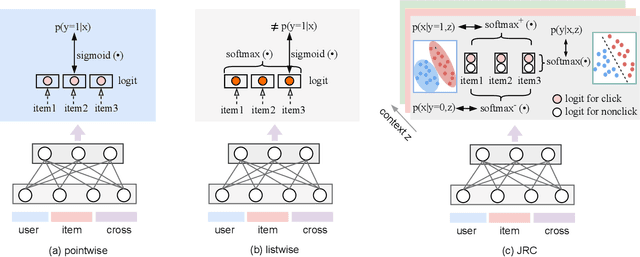



Abstract:Despite the development of ranking optimization techniques, the pointwise model remains the dominating approach for click-through rate (CTR) prediction. It can be attributed to the calibration ability of the pointwise model since the prediction can be viewed as the click probability. In practice, a CTR prediction model is also commonly assessed with the ranking ability, for which prediction models based on ranking losses (e.g., pairwise or listwise loss) usually achieve better performances than the pointwise loss. Previous studies have experimented with a direct combination of the two losses to obtain the benefit from both losses and observed an improved performance. However, previous studies break the meaning of output logit as the click-through rate, which may lead to sub-optimal solutions. To address this issue, we propose an approach that can Jointly optimize the Ranking and Calibration abilities (JRC for short). JRC improves the ranking ability by contrasting the logit value for the sample with different labels and constrains the predicted probability to be a function of the logit subtraction. We further show that JRC consolidates the interpretation of logits, where the logits model the joint distribution. With such an interpretation, we prove that JRC approximately optimizes the contextualized hybrid discriminative-generative objective. Experiments on public and industrial datasets and online A/B testing show that our approach improves both ranking and calibration abilities. Since May 2022, JRC has been deployed on the display advertising platform of Alibaba and has obtained significant performance improvements.
PICASSO: Unleashing the Potential of GPU-centric Training for Wide-and-deep Recommender Systems
Apr 17, 2022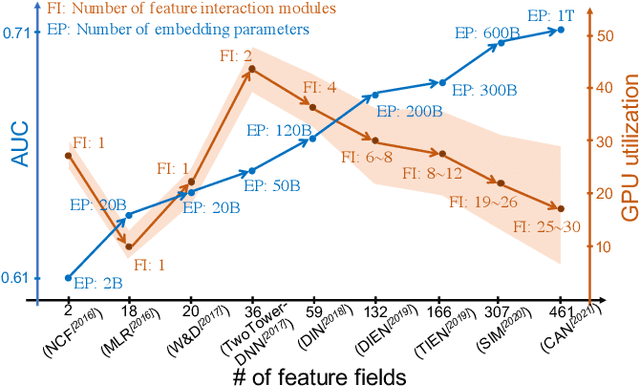


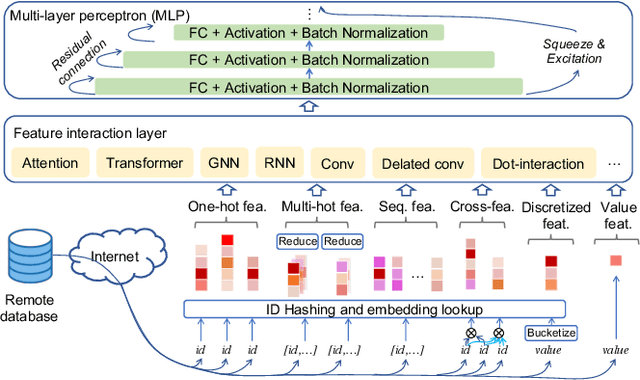
Abstract:The development of personalized recommendation has significantly improved the accuracy of information matching and the revenue of e-commerce platforms. Recently, it has 2 trends: 1) recommender systems must be trained timely to cope with ever-growing new products and ever-changing user interests from online marketing and social network; 2) SOTA recommendation models introduce DNN modules to improve prediction accuracy. Traditional CPU-based recommender systems cannot meet these two trends, and GPU- centric training has become a trending approach. However, we observe that GPU devices in training recommender systems are underutilized, and they cannot attain an expected throughput improvement as what it has achieved in CV and NLP areas. This issue can be explained by two characteristics of these recommendation models: First, they contain up to a thousand input feature fields, introducing fragmentary and memory-intensive operations; Second, the multiple constituent feature interaction submodules introduce substantial small-sized compute kernels. To remove this roadblock to the development of recommender systems, we propose a novel framework named PICASSO to accelerate the training of recommendation models on commodity hardware. Specifically, we conduct a systematic analysis to reveal the bottlenecks encountered in training recommendation models. We leverage the model structure and data distribution to unleash the potential of hardware through our packing, interleaving, and caching optimization. Experiments show that PICASSO increases the hardware utilization by an order of magnitude on the basis of SOTA baselines and brings up to 6x throughput improvement for a variety of industrial recommendation models. Using the same hardware budget in production, PICASSO on average shortens the walltime of daily training tasks by 7 hours, significantly reducing the delay of continuous delivery.
One Model to Serve All: Star Topology Adaptive Recommender for Multi-Domain CTR Prediction
Jan 27, 2021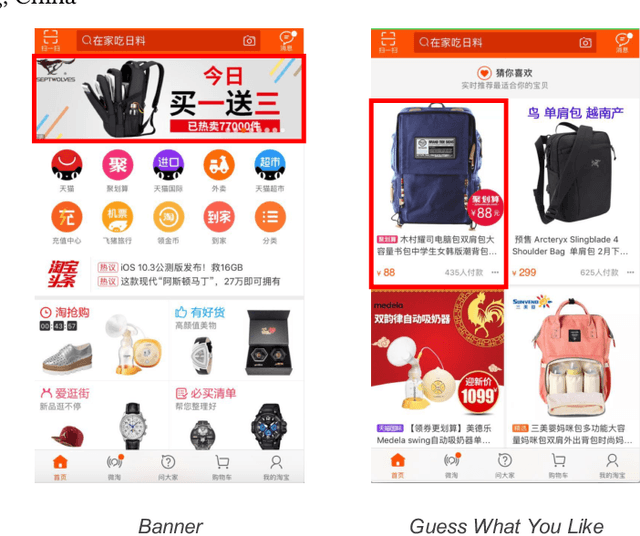

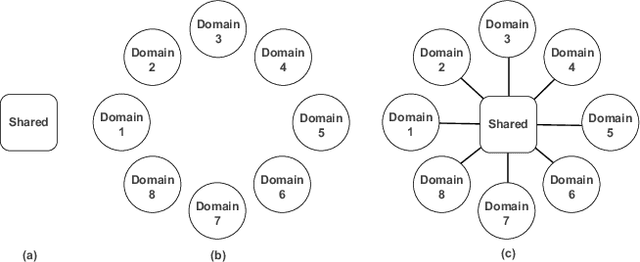
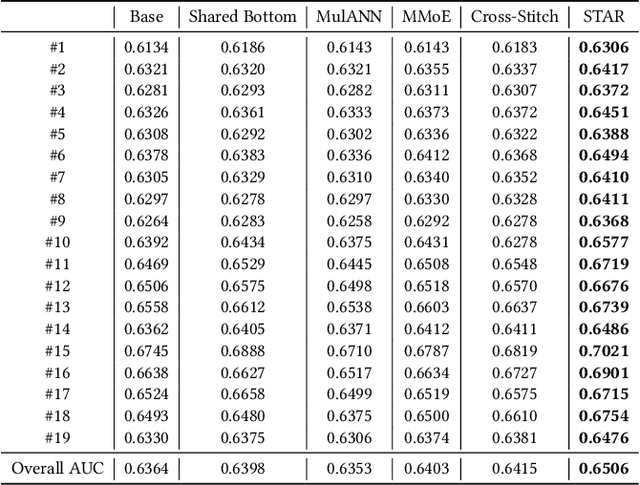
Abstract:Traditional industrial recommenders are usually trained on a single business domain and then serve for this domain. In large commercial platforms, however, it is often the case that the recommenders need to make click-through rate (CTR) predictions for multiple business domains. Different domains have overlapping user groups and items, thus exist commonalities. Since the specific user group may be different and the user behaviors may change within a specific domain, different domains also have distinctions. The distinctions result in different domain-specific data distributions, which makes it hard for a single shared model to work well on all domains. To address the problem, we present Star Topology Adaptive Recommender (STAR), where one model is learned to serve all domains effectively. Concretely, STAR has the star topology, which consists of the shared centered parameters and domain-specific parameters. The shared parameters are used to learn commonalities of all domains and the domain-specific parameters capture domain distinction for more refined prediction. Given requests from different domains, STAR can adapt its parameters conditioned on the domain. The experimental result from production data validates the superiority of the proposed STAR model. Up to now, STAR has been deployed in the display advertising system of Alibaba, obtaining averaging 8.0% improvement on CTR and 6.0% on RPM (Revenue Per Mille).
 Add to Chrome
Add to Chrome Add to Firefox
Add to Firefox Add to Edge
Add to Edge